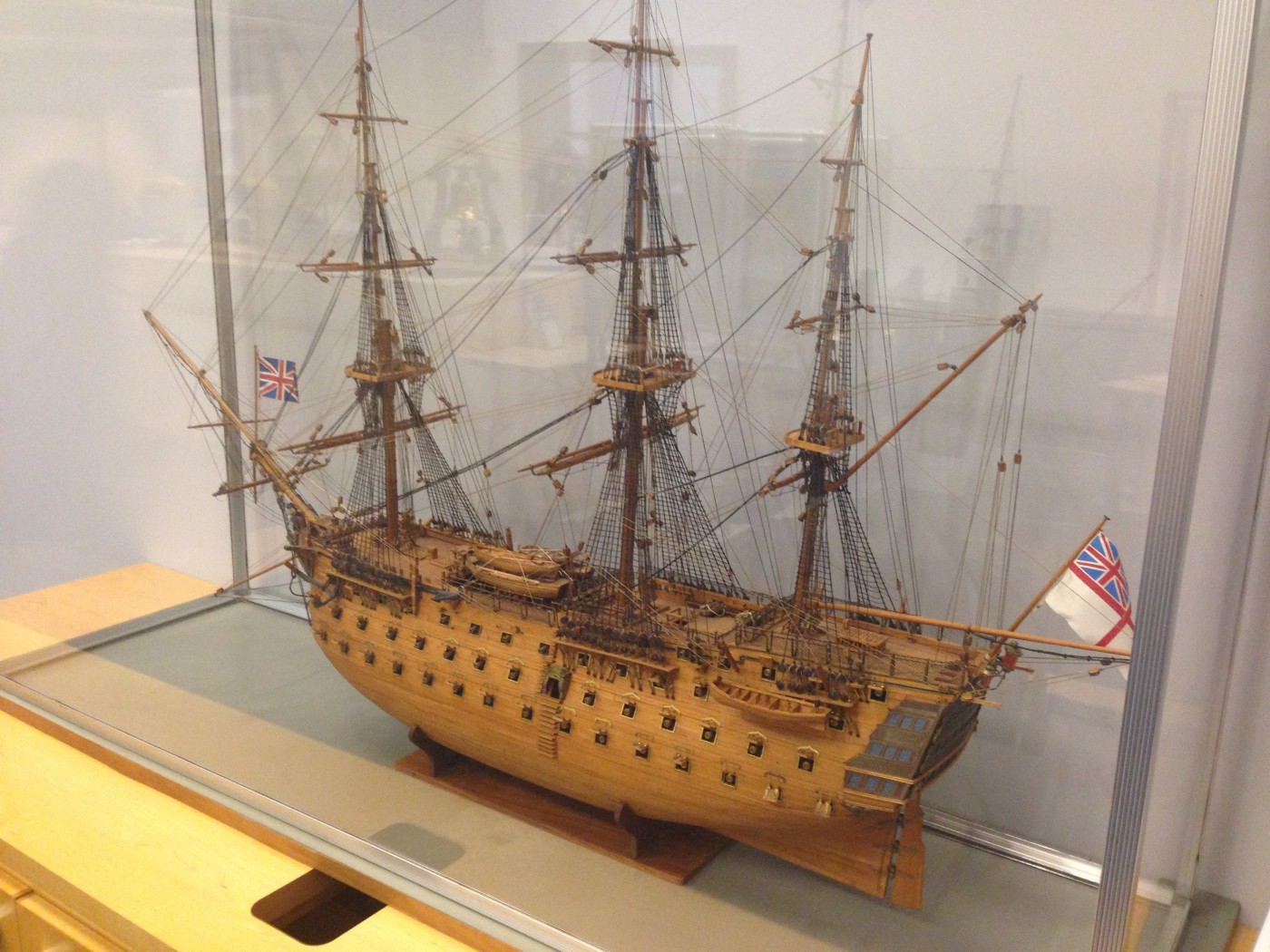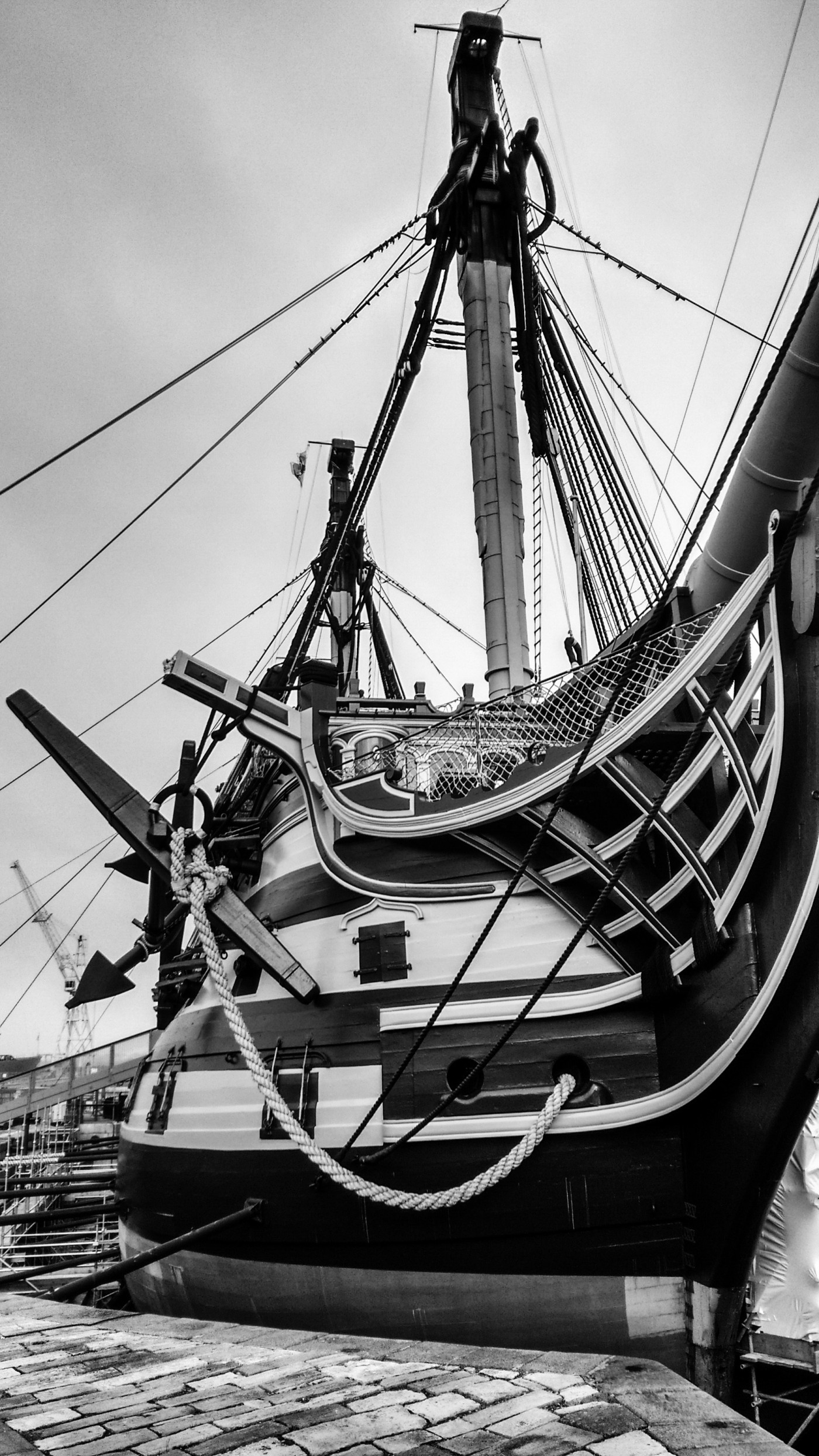Thursday, February 22 2018
As the newest member of the HEC team, I have spent quite a bit of time wandering around the archives and the building, taking in all the history and heritage. As I have recently graduated with a Masters degree in Naval History, with a particular passion for long-eighteenth century naval warfare, I was immediately drawn to a wonderful model of HMS Victory that sits outside the office. As it was the Victory and her stories that sparked my interest in naval and maritime history as a child, I have chosen it as my ‘favourite thing’.
We have various models of ships around the centre that have been collected over the years by a member of the team. The model itself was made by model maker who undertook these projects as a hobby. When he died, his widow wanted to ensure that this beautiful and intricate model went to a good home where it would be displayed and appreciated. She was put in touch with us and we of course said yes!
It is made out of late twentieth century plank, fitted with full rigging, a complement of guns and a metal figurehead. One element the model that differs from the Battle of Trafalgar configuration that Victory has been restored to, is the famous ‘Nelson Chequer’. Officers were initially given great leeway with how they painted their ships. However in 1780, the Admiralty issued an order stating that they should either be yellow or black. When Victory became Nelson’s flagship he had her painted with his signature yellow and black stripes (which is how you see her today). When the gun ports were open and the ship was ready for action she would appear ‘chequered’ and when closed she would appear ‘striped’. Following the Battle of Trafalgar, the colour scheme became popular across the Royal Navy.

HMS Victory, a 104-gun first-rate ship of the line, was launched on 7 May 1765 from Chatham Dockyard. She first saw active duty in March 1778 at the Battle of Ushant as Admiral Keppel’s flagship. The battle was indecisive and Keppel was court-martialled for ‘neglecting his duty’, eventually being acquitted of the charges. As a flagship, the Victory then took part in the second Battle of Ushant (a British victory won by Rear Admiral Kempenfelt), the Siege of Gibraltar and the Battle of Cape St Vincent (a decisive British victory under the command of Sir John Jervis). Following St Vincent, she was declared unfit for service and converted into a hospital ship. However, in 1799, when HMS Impregnable was lost, the Admiralty, now lacking a first-rate ship, ordered for the Victory to be made seaworthy again. In 1803, a newly refurbished Victory sailed from Chatham to Portsmouth where she took on her most famous role, Vice-Admiral Lord Horatio Nelson’s flagship.

On the 21 October 1805, Victory took part in the Battle of Trafalgar, arguably her finest hour. The outnumbered British fleet, led by Nelson, faced the combined fleets of the French and Spanish navies, led by Vice Admiral Pierre-Charles Villeneuve, at Cape Trafalgar. Victory led the ‘Weather Column’ of the British attack, with second-in-command Vice-Admiral Cuthbert Collingwood leading the ‘Lee Column’ on Royal Sovereign. Nelson’s battle plan was for the two columns to cut the enemy line into thirds, making it easier to defeat the greater force. This tactic formed part of the famous ‘Nelson Touch’.
As the British fleet approach the Combined Fleet Nelson, wanting to rouse his men to victory, appeared on deck, wearing his full uniform, and ordered for the signal ‘ENGLAND CONFIDES THAT EVERY MAN WILL DO HIS DUTY’. It was suggested by Mr Pasco, the Victory’s signal officer, that the word ‘confides’ be substituted for ‘expects’ as the latter was in the signal book and confides was not. Nelson agreed. A couple of hours after engaging with the enemy, at around one o’clock, the Victory had locked masts with the Redoutable and was engaged in a general melee. It was during this skirmish that Nelson was hit by a musket ball fired from the mizzentop of Redoutable. He was taken below deck where it was soon realised that he would not recover. Nelson died three hours later, knowing that the battle had been won. Collingwood took command and, realising that the ensuing storm could destroy the fleet, ignored Nelson’s final command to anchor the fleet, as many ships were too damaged to anchor, and instead focused on taking damaged vessels in tow. Collingwood’s actions meant the loss or damage of several prize ships but he was able to save every British ship. The Victory had been severely damaged during the battle. She had to be towed by HMS Neptune into Gibraltar for repairs. She then carried Nelson’s body to Greenwich. He was subsequently buried at St Paul’s Cathedral on 9 January 1806.
Following the Battle of Trafalgar, the Admiralty deemed the Victory too old to restore as a first-rate ship-of-the-line and she was relegated to second-rate. In 1812 she was stationed in Portsmouth Harbour to be used as a depot and prison ship. From 1824-1830, she was used as Portsmouth Harbour’s Port Admiral’s flagship. In 1831, the Admiralty wanted to break her up and use her wood for other ships. This was prevented from happening by a public outcry. Victory’s popularity was aided by two visits made by Queen Victoria once, in 1833, as a Princess and again in 1844 as Queen. She noted in her diary that:
“We went below, down, I think, 3 or 4 decks, quite to the bottom of the ship & saw the little hold in which poor Nelson died, it was very interesting, & I am so glad we visited the ship” [1]

Despite the increased interest in Victory (she had 22,000 visitors on average per year); the Admiralty left her to rot. In 1903 the Admiralty suggested she be scrapped as they could not afford to repair her (due to the naval arms race with Germany). This suggestion was stopped by Edward VII. In 1921, a public Save the Victory campaign was launched. She was moved into No 2 dock in Portsmouth, the oldest dry dock in the world still in use, where she still sits today, and restoration works began. During the Second World War, a bomb, dropped by the Luftwaffe, destroyed parts of the Victory. By the time of the Trafalgar 200 celebrations in 2005, something I had the pleasure of attending after winning a competition, the Victory had been restored to her Battle of Trafalgar configuration. Restoration works are still ongoing including the replacement of her upper masts and full complement of rigging. Victory, the oldest commissioned warship in the world, now forms part of the National Historic Fleet and is the First Sea Lord’s flagship. Restoration works are still going on but she remains open to the public for tours.
Victory is one of the most iconic heritage sites in the world and, thanks to careful conservation and public interest; she can still be enjoyed by 100s of thousands of visitors every year.
Photographs by Charlotte Ward
To receive our monthly HEC newsletter, please sign up here.
- [1] Queen Victoria, Monday 21st October 1844, Queen Victoria’s Journals Online, [accessed 5 February 2018]

